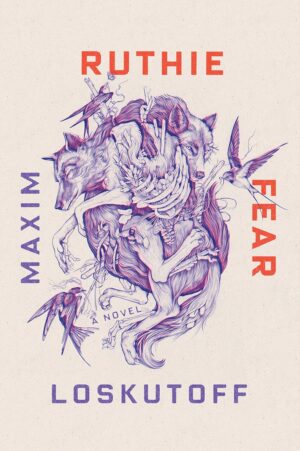Ruthie Fear
by Maxim Loskutoff
reviewed by Donna Henderson
The titular character of Maxim Loskutoff’s debut novel lives with her father, Rutherford, and their dog, Moses, at the base of Trapper Peak in the Bitterroot Mountains of Montana. Theirs is the hardscrabble way of life common to the often-overlooked rural communities of the American West, where mills have closed and the work of farming and ranching demand far more than they return. For Ruthie Fear, it is also a way of life shaped and controlled by men (even her name is an extension of her father’s), and at odds with her profound, innate sense of connection to both the natural and supernatural world.
Near the beginning of the novel, Ruthie, aged six, sees an apparition: a creature, birdlike and headless, in the canyon behind her house. She is terrified, but in her terror she also feels “a terrible importance, as if fate were for a moment balanced in her hands.” From this ominous beginning unfolds a powerful story about the disenfranchised and of the bitterness, despair, and bewilderment that haunt their lives. It is also the story of how one girl is both troubled and shaped by these emotions as she navigates her own “stubborn and wild” way into womanhood.
In Darby, catastrophe could—and does—happen at any moment. The local mill, which has been the community’s main employer, has recently closed. Its property is now owned by the Rocky Mountain Labs secretive biolab complex, whose scientists scorn and ignore the local citizenry. As local poverty increases and resentment builds, so do tensions between the indigenous Salish and white communities. Ruthie, who has friends in both groups, struggles to navigate her own conflicting loyalties, as well as her intensifying inner contradictions and impulses. The natural world, too, poses a threat, with wildfires increasing in ferocity each summer. When the first earthquake in twenty-seven years hits the town, it only intensifies the community’s feeling of having no solid ground on which to stand.
As the years pass, Ruthie remains haunted by her memory of the surreal, headless creature she encountered as a child; a creature which from which a sense of pure evil had seemed to emanate. As she enters adolescence, she begins to associate this sense of evil with the presence of the biolab complex. The plant, which seems to have been “designed to avoid any suggestion of menace,” is, like the creature, “huge” and “faceless.” Ruthie, along with many of the inhabitants of Darby, attends rallies to protest the plant’s presence and secrecy. But the town protests are swiftly defused by the scientists’ obfuscations and bland reassurances—and, ultimately, by the corporate and government money that insulates them from the need for local approval.
As Ruthie struggles to navigate the tensions, traumas, and losses suffered by her community, we see her at once increasingly troubled and increasingly shaped by the violence around her. Hers is a hair-trigger world, in which firearms are power’s singular, cherished means, ubiquitous and iconic. One of the book’s most memorable passages is its description of Ruthie’s father’s relationship with his Banshee rifle:
Rutherford hopped down from his truck, circled the bed, and leaned in to carefully remove the Banshee from its black leather case. [ … ] He relished any opportunity to show it off. He held the barrel gently in his fingers, as if he were afraid to jar the pollen and spoil the bloom. It weighed only four pounds. Ruthie remembered lifting it alone in his room when she was a little girl [ … ] “You can’t be ashamed of your gun,” her father had said.
As in his 2018 collection of short stories, Come West and See, Loskutoff neither divides his characters into villains and victims nor presents them as objects of condescension or condemnation. His focus is rather on the ways in which conditions that produce despair create and maintain the kind of collective psychic inflammation that can incite the impulse to violence—even rampage—in any of us. It’s an impulse from which some of us are more insulated than others, but none of us is immune.
Published on December 1, 2020

